#edible wild plants
Text

Do you like ginger and/or cardamom?
Do you also like free spices?
WELL HI let me introduce you to magnolia buds! Yes, the same buds that eventually become those lovely pink flowers you see growing on trees every spring.
Magnolia flowers are edible at all stages, but when you pick them like this just before they open, they are PERFECT for drying and using as a spice. If the buds are already open, don’t bother. I don’t know what it is about the petals, but they do NOT dry well and the smell becomes almost fishy.
I slice the buds open lengthwise, and separate any thick outer layers before drying. An oven won’t work for this unfortunately — the flavor is really too delicate. I put them in a dehydrator on its lowest setting for most consistent results, but air drying will also work. The only thing about that is it’s very important that the buds remain dry. Any moisture and you risk ruining a whole batch.
They shrink a lot once they’re fully dry, so I don’t bother crushing them up when finished. I store them in a clean, dry mason jar and they last easily for a few months (if I don’t use them before then)! Use anywhere you would ginger or cardamom – they make an excellent addition to cookies and spice cakes!
* Always forage responsibly and NEVER eat anything you aren’t 100% sure of. When in doubt, throw it out! *
193 notes
·
View notes
Text
How to Identify Red Deadnettle
Originally posted on my website at https://rebeccalexa.com/how-to-identify-red-deadnettle/
Name: Red Deadnettle (Lamium purpureum)
Range and typical habitat(s): Native to large areas of Europe and Asia. Introduced invasive in United States, New Zealand, and scattered areas of South America

Distinguishing physical characteristics (size, colors, overall shapes, detail shapes): Keep your eyes on lawns, gardens, roadsides, and other sunny areas this spring, and you may very well see the green and purple foliage of red deadnettle.
These heart-shaped leaves with softly serrated edges are covered in fine hairs. Leaves near the top of the slender, square-shaped stem are more of a reddish purple hue, while lower, larger leaves are a medium green. The leaves rarely exceed an inch and a half in length, and are attached to the stem with a slender stalk. Each leaf has palmate veins–several primary veins all starting near the stem–branching off multiple times into a reticulated network of smaller veins.

At the top of the stem, which may be almost a foot long in extraordinary specimens, you may find tiny pinkish purple trumpet-shaped flowers. A close look reveals one large petal at the top, two smaller ones at the bottom, and sometimes a few tiny ones in the space in between. While flowers are easily in evidence this time of year, red deadnettle may flower in other seasons if conditions are favorable. As it is an annual, it will die back in fall, but new generations are quick to germinate before winter sets in. For those wishing to remove it from their gardens, the shallow root systems mean that it is easy to pull up, especially in wet soil.
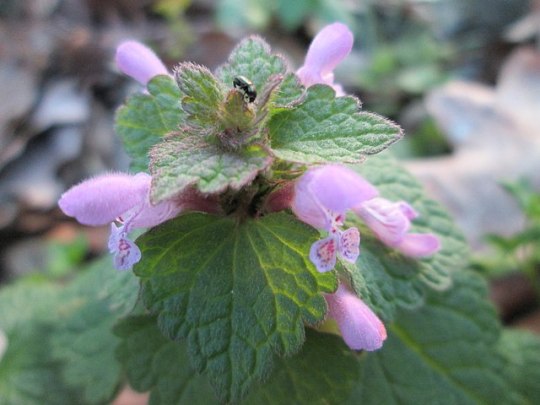
Red deadnettle is a member of the mint family (Lamiaceae). While it resembles a very tiny stinging nettle (Urtica spp.), its tiny hairs do not cause irritation, hence being described as “dead”. Other common names for this plant include purple deadnettle and purple archangel.
Other organisms it could be confused with and how to tell the difference: Purple henbit (Lamium amplexicale) is the most common lookalike for red deadnettle. They inhabit the same habitat types and are of similar size and colors. Upon closer inspection, the leaves are a good way to tell the difference. Henbit leaves are more rounded in shape with a scalloped, rather than serrated, edge. In fact, they almost give the impression of one large round leaf surrounding the square stem, especially near the top. The upper leaves have no stalks, while lower leaves have short stalks. While henbit has similar flowers, they are longer than those of deadnettle.

Note how henbit’s leaves and flowers are shaped and arranged differently than deadnettle’s.
Ground ivy (Glechoma hederacea) is similar to purple henbit, but the rounded, scalloped leaves are often a darker green on a green to dark red stem. Also, all the leaves have a small stem. It is easily differentiated from deadnettle by its flowers, which although being of a similar shaped are blue to purple in color. Ground ivy is also more shade-tolerant than deadnettle. As with the others, it is a European plant that has become invasive in North America.
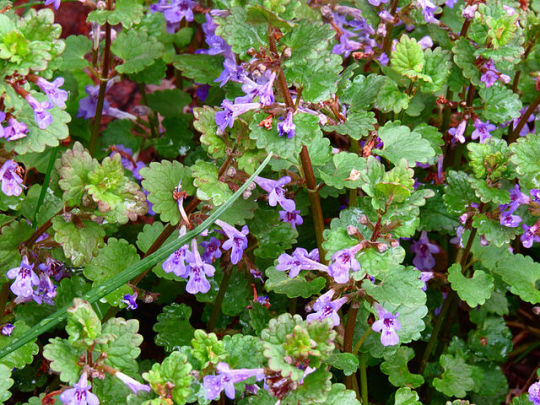
Yellow archangel (Lamium galeobdolon) is yet another European wildflower that has taken root in North America and New Zealand, and to a lesser degree in South America. Its size is the most obvious way to differentiate it from red deadnettle and the rest; it grows on a single stalk that may be over thirty inches tall. The serrated, oval leaves and the yellow flowers are also larger than those of deadnettle, and there is no reddish tint to the foliage.
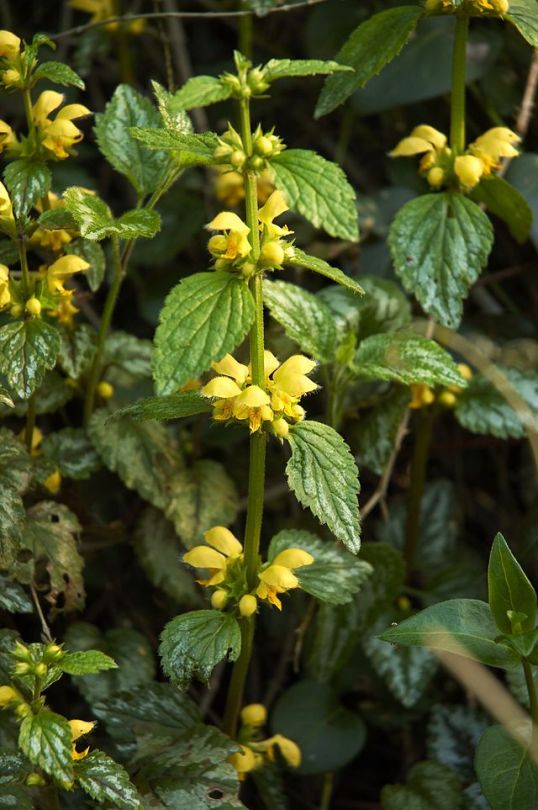
The stinging nettles (Urtica spp.) can similarly be differentiated from red dead nettle by size. Particularly tall specimens may reach seven feet high, and the green, heart-shaped leaves can be up to six inches long. The leave margins are more sharply serrated and the end is pointier. And, as the name suggests, the leaves and stems have hairs that inject irritating chemicals into the skin.
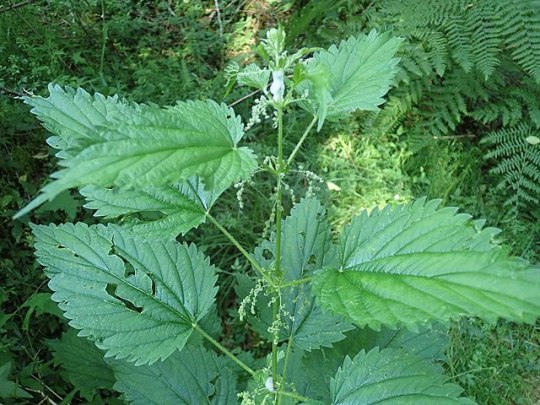
Anything else worth mentioning? Red deadnettle is a beginner-friendly edible plant for foraging. Henbit is the plant it’s most likely to be confused with, and it is also edible. People most commonly eat the young leaves and flowers at the top of the plant; they may be eaten raw or cooked. Because it is an invasive species, you are encouraged to pick the whole plant before it goes to seed, eat what you want of it, and compost the rest.
Further Reading:
Red Dead-Nettle
Lawn and Turfgrass Weeds: Dead Nettle
Dead Nettle, Henbit, and Ground Ivy – Three Look-Alike Weeds
Dead Nettle, an Overlooked yet Valuable Wild Edible
Did you enjoy this post? Consider taking one of my online foraging and natural history classes or hiring me for a guided nature tour, checking out my other articles, or picking up a paperback or ebook I’ve written! You can even buy me a coffee here!
#red deadnettle#red dead nettle#mint family#edible wild plants#edible plants#foraging#herbs#herbalism#nettles#botany#plants#wild foods#weeds#invasive species#red henbit#yellow archangel#ground ivy#stinging nettle
87 notes
·
View notes
Text
Virginia Bluebells (Mertensia virginica)
Blue flowers are relatively rare. Most incline to violet or else are quite small. But Virginia bluebells are a striking exception. All my photos from my garden, unedited.


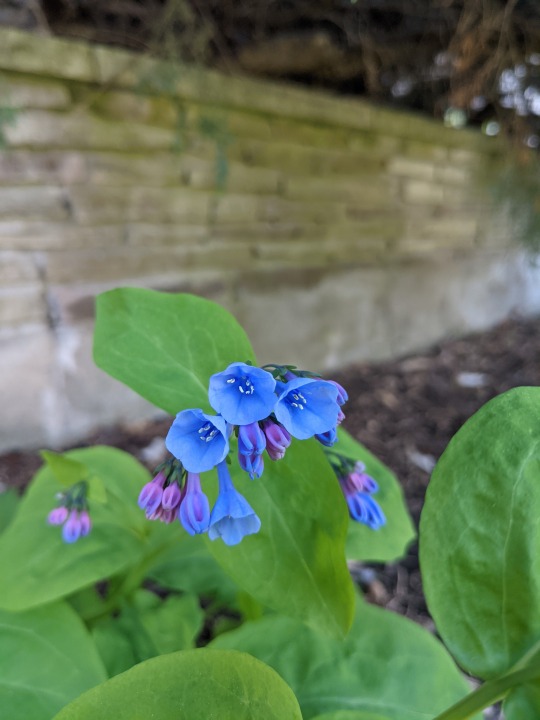



I'm not kidding. They really are that blue naturally. They bloom in May. Then they slowly decline and the entire plants are gone above soil by the summer. Only to reappear the following spring! The shoots and flower buds are edible. You don't want to take too much, though. As spring ephemerals, they need the energy they make with their leaves during their short growing period. The short bloom period is also why I don't have more photos of them. They don't even bloom every year.
#photography#my photos#blackswallowtailbutterfly#Virginia bluebells#Mertensia virginica#flowers#blue flowers#wildflowers#gardening#native species#North American native plants#edible wild plants#my garden#native plants of Ontario and the northeastern USA#spring ephemerals
15 notes
·
View notes
Text
Inktober (Falloutober) day 2
I promise I didn’t forget it’s Inktober! I understand that one of today’s prompts for those of us doing Falloutober variants (I’m too lazy to look any of the lists up so I’m cribbing the prompt off @twosides--samecoin 😂) was Blossoms. Please welcome Duncan MacCready and my LW Ben Jamison being very silly for today’s prompt (er, yesterday’s now).

I know y’all are used to seeing yucca as environmental foliage/a consumable item in FNV, but fun fact: in the US yucca isn’t confined to the Southwest - we have plenty on the East Coast as well, including in the DMV, and it is very hardy! So, I choose to believe it’s available in the FO3/FO76 map areas. Adam’s Needle is the yucca species that grows here, and several parts of the plant (aside from the very toxic stems) are edible including the flowers, fruit and roots - as these doofs are currently demonstrating.
#Inktober#inktober2022#falloutober#falloutober2022#duncan maccready#ben jamison#benjamin jamison#lone wanderer#fallout#fallout 3#fallout 4#oneifbyland#lettersfromhome#yucca blossom#edible wild plants#tastes like artichoke#also great deep fried#om nom nom#eda draws
11 notes
·
View notes
Text
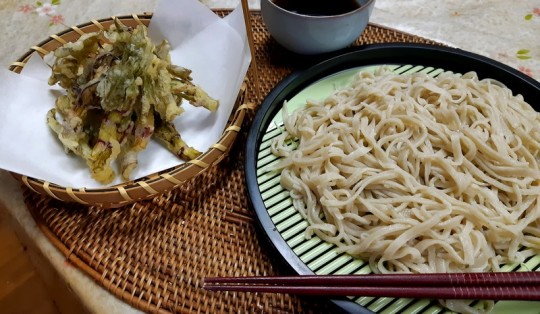
Homemade buckwheat noodles and deep-fried shoots of an edible wild plant.
One way to enjoy spring in a countryside. :)
2 notes
·
View notes
Text
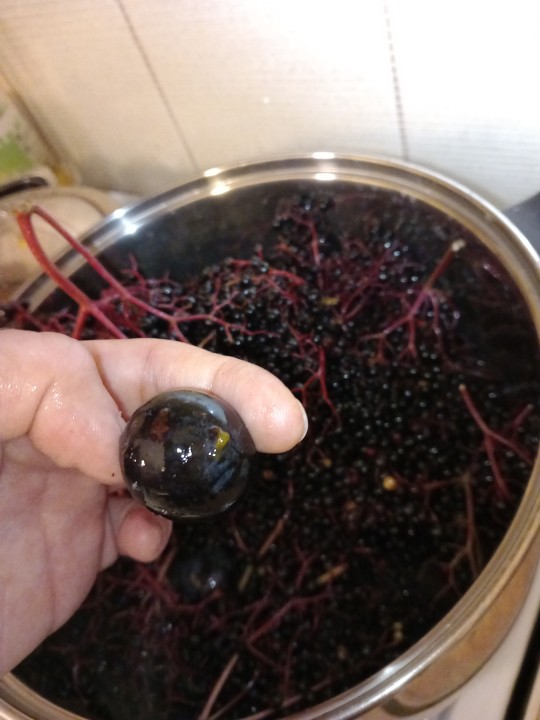

Modest harvest from today's escapade to the long abandoned orchard - elderberries (half of a big pot), some tiny plums and apples. I'm gonna come back there tomorrow with a better more resiolient trashbags for more goods :)
5 notes
·
View notes
Text
Why asteraceae, especially daisies, is mai fafurite wildflowers 🌼! Wat is yoo fafurite flowers? --Loki💛😺
#cats#cat#plushie#puppet#stuffed animals#puppetry#plush animal#plush toys#puppets#plush cat#depression#daisies#daisy#asteraceae#wildflowers#wildflower#favorite flower#ox eye daisies#foraging#edible wild plants#wholesome
2 notes
·
View notes
Text
Just added to Etsy!
~ "Stalking the Wild Asparagus: Field Guide Edition" by Euell Gibbons (1972)
#Stalking the wild asparagus#Euell Gibbons#edible wild plants#vintage books#vintage book seller#book seller#vintage etsy#vintage etsy seller#etsy seller#vintagecdchyld#vintage#etsy#books books books#books for sale#vintage books for sale
0 notes
Text
In honor of a bunch of my friends being served iris rhizomes instead of daylily bulbs at a skills event and puking their guts out all night, here is a friendly reminder about wild edibles:
Do not eat any wild edibles that are at all new to you or you are even a little uncertain about without double and triple checking the ID with a trusted, professional resource. ABSOLUTELY DO NOT feed wild edibles to anyone else that you haven't repeatedly IDed and eaten yourself with no problems.
#there is very little space to be uncertain with wild edibles ESPECIALLY when you are sharing them#(also anyone who makes THAT particular mistake needs to go back to the drawing board & learn how to look at plants because how do you even-#wild edibles#foraging#plantblr#thank god it wasnt a more dangerous mistake and all that happened was 50% of the group throwing up for a night#raincoats speaks
2K notes
·
View notes
Text

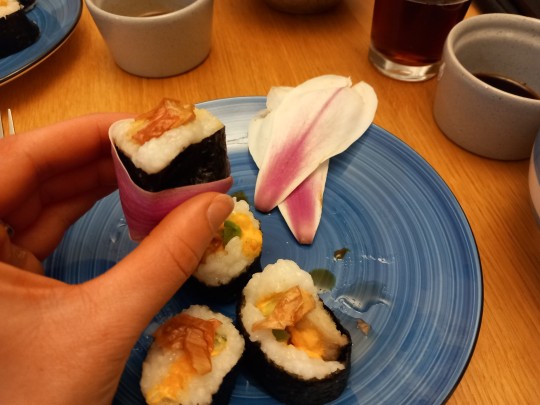
This is how I use pickled magnolia petals - as ginger on homemade sushi! I also love it enough to enjoy wrapping a fresh blossom around each piece to eat it too.
The miso soup features wild garlic, another wonderful spring time edible.
168 notes
·
View notes
Text
I desperately need more botany/gardening/solarpunk/foraging posts that aren’t so fucking American-centric
“European plants are invasive” okay, in America— but which ones are invasive HERE, like are Spanish species invasive to England? Are French plants invasive to England??
#we’re a fucking island but we’re also in Europe and I need more shit about wildflowers or invasive species or edible foraging plants in UK#wild flowers#wildflowers#england#scotland#ireland#wales#including those three too cause it’s probably a very similar issue#I mean maybe I’m just not looking in the right places but everything I ever come across is American or Canadian#UK#solarpunk#botany#foraging#foragecore#foraged food#🪲#botanic garden#garden design
247 notes
·
View notes
Text
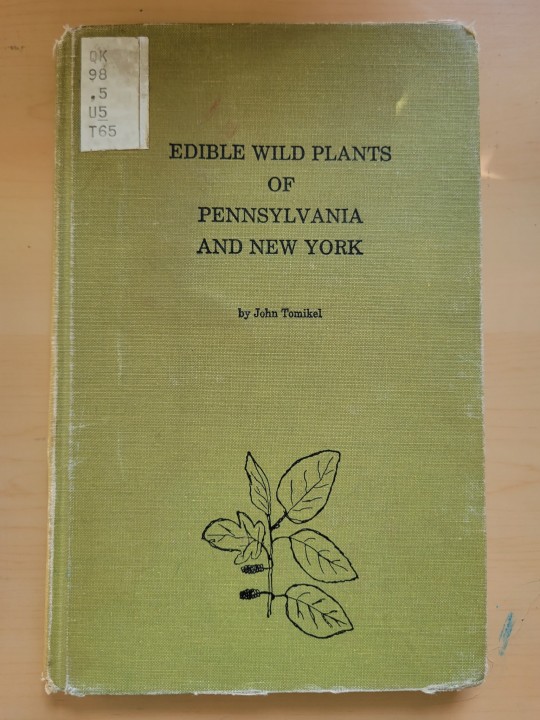



At the beginning of the summer, I had big plans to better my plant ID knowledge and foraging, and staggered home from the library with a giant stack of guidebooks. Which went entirely unread until now, unfortunately. Some of them were older books which I'm flipping through more out of curiosity and an appreciation for line drawings rather than for practical advice - this one is from 1973 and I'm supremely charmed by the author's voice, particularly his attitude of "just because I'm writing the book you're reading about edible plants doesn't mean you should trust anything I say."
298 notes
·
View notes
Text

Winter may be almost over in the northern hemisphere, but in many places it's going to be a bit before spring foraging can begin in earnest. See what edible plants and mushrooms you may be able to find right now in my chapbook Winter Foraging: Forty (Or So) Wild Foods to Look For--just $6 for the paperback and $3 for the ebook!
#foraging#mushroom hunting#mushroom foraging#winter foraging#forager#wild foods#edible wild plants#edible mushrooms#fungi#fungus#food#wild food#outdoors#nature#chapbook#self publishing
14 notes
·
View notes
Text
Michigan lilies (Lilium michiganensis)
These are from my garden. Unedited. They're also the real deal. Not a cultivar, not a hybrid. They really grow like this in the wild.

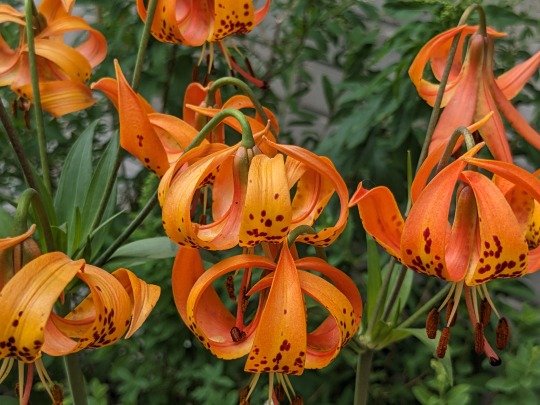

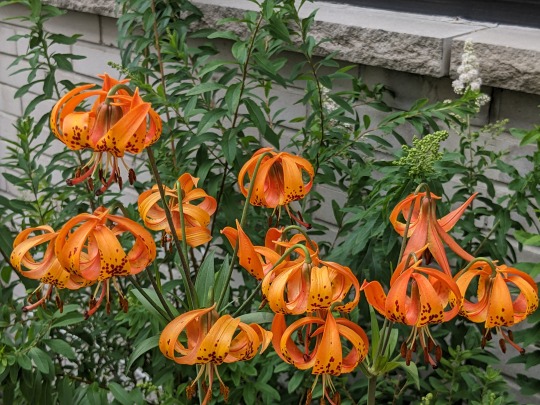







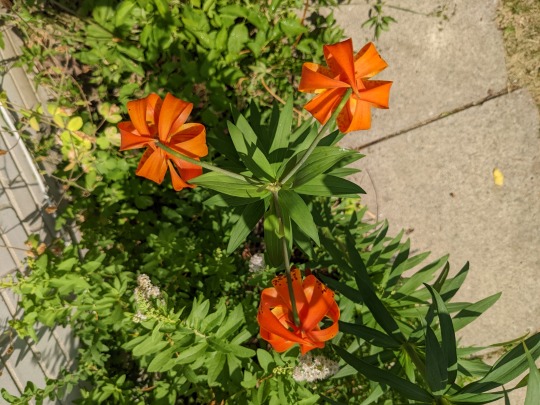
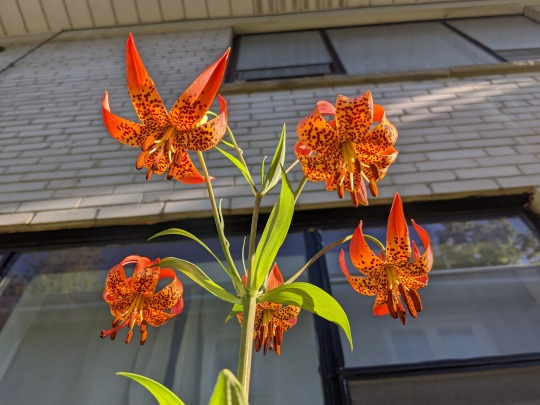

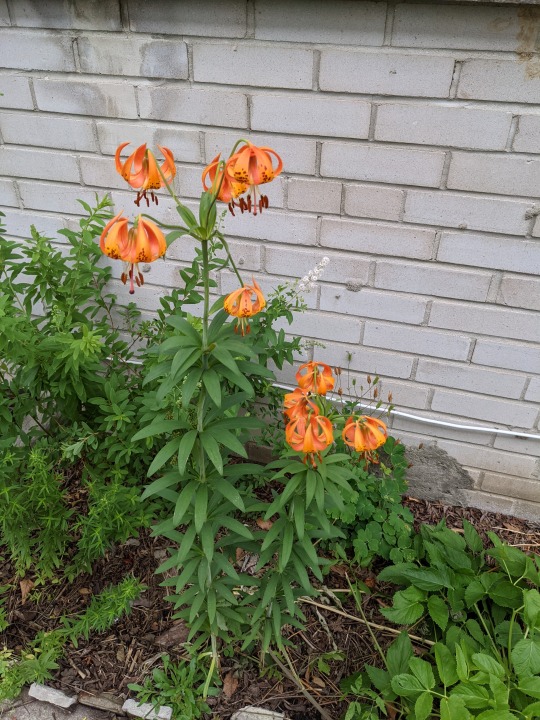
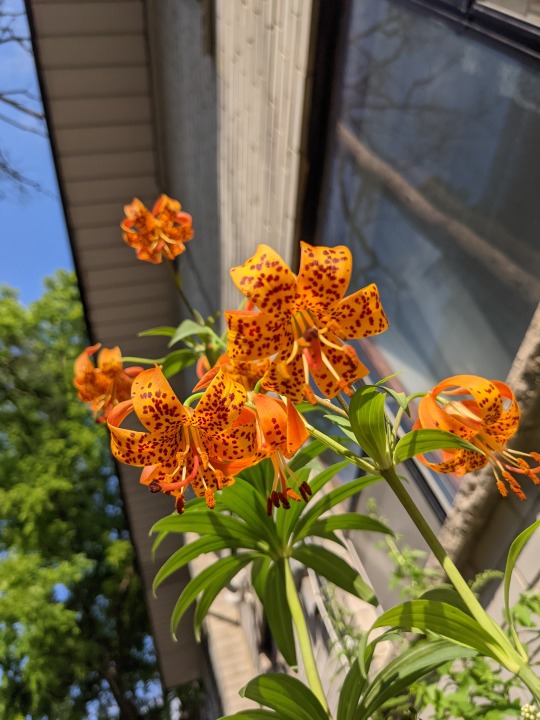
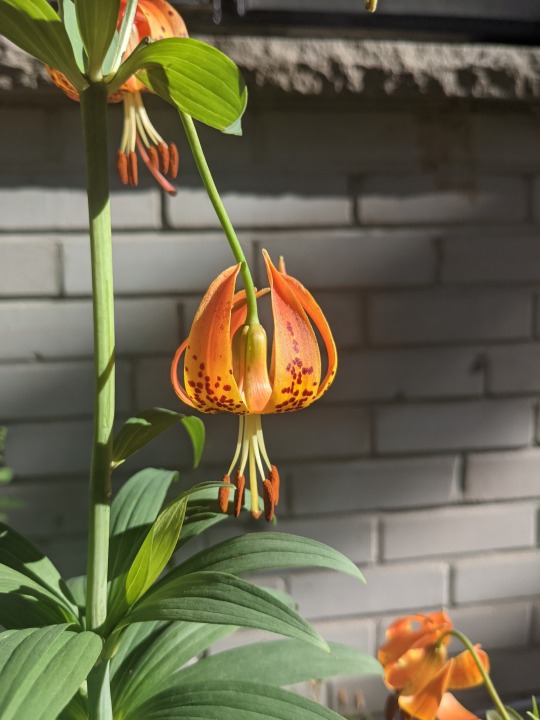



They bloom in June and spread slowly but exponentially. Flower petals and bulbs are edible cooked (all parts are toxic to cats and dogs though). :)
#photography#my photos#blackswallowtailbutterfly#Michigan lily#Lilium michiganensis#flowers#lilies#true lilies#orange flowers#wildflowers#gardening#native species#North American native plants#edible wild plants#my garden#native plants of Ontario and the northeastern USA
7 notes
·
View notes
Text
comprehensive list of edible flowers to celebrate spring!:
magnolias (they taste like ginger)
dandelions (only eat the yellow stuff not the bitter green stuff)
violets (if u make tea from them then add lemon it turns pink! tastes earthy and mildly sweet)
lilac (they're bitter on their own but if you put a flower head in cold water for a couple hours it makes the most divine, refreshing spring drink)
marigolds (kinda peppery, v fun in salads-- used as a sub for saffron in cooking)
rose (the og edible flower, most are very floral and taste like how they smell, they make for an excellent tea as well!)
nasturnium (very peppery, almost like horseradish-- not my fav but if u like it go off i guess)
peonys (mildly sweet, floral flavor and fun to eat off the bush)
wood sorrel (the flowers are small so it barely made it onto this list but they taste like little bombs of green apple so go eat them--also eat the leaves!)
daisy (some say the yellow center tastes like pineapple-- i think its a bit of a stretch but they are sweet and tasty nonetheless!)
red clover (the flower heads can be white or pink-- the pink ones are the sweeter ones)
redbud (these grow on trees in v early spring-- they taste exactly like snap peas.)
always remember to do research before eating any wild plant, and always be 100% certain that u have the right one-- also don't eat stuff that might be contaminated with pesticides
#plants#flowers#wild edibles#edible flowers#nature#cottagecore#flower aesthetic#gremlincore#ive seen a lot of ppl talking abt how the leaves of dandelion are edible#i know#but raw theyre bitter
337 notes
·
View notes
Text


Plant of the Day
Saturday 13 January 2024
The tropical herbaceous perennial plant Etlingera elatior (torch ginger, ginger flower, red ginger lily, torchflower, torch lily, wax flower, wild ginger) needs a warm, humid climate. It produces a spreading clump with dramatic flowers which can be eaten when in bud having a crisp and succulent texture.
Jill Raggett
#Etlingera#torch ginger#ginger flower#red ginger lily#torchflower#torch lily#wax flower#wild ginger#herbaceous#perennial#tropical glasshouse#tropical#red flowers#edibles#plants#horticulture#gardens#herbaceousperennial
147 notes
·
View notes